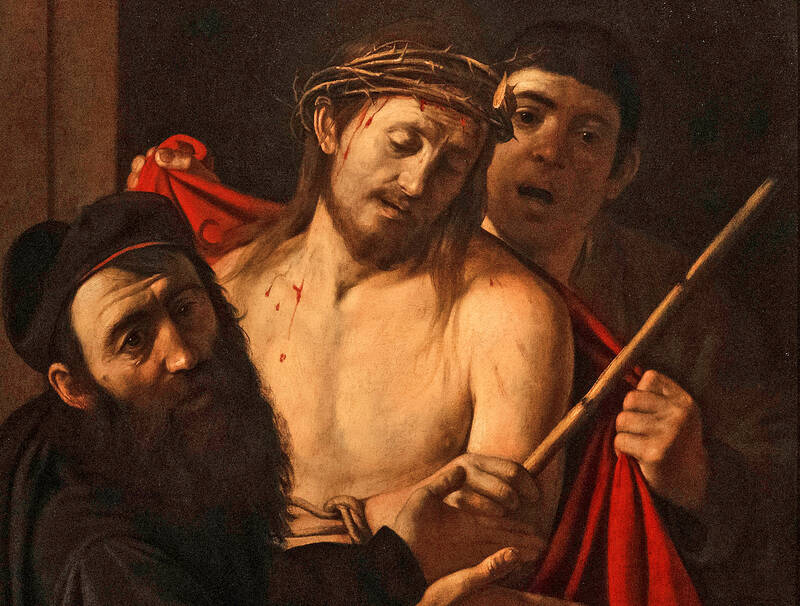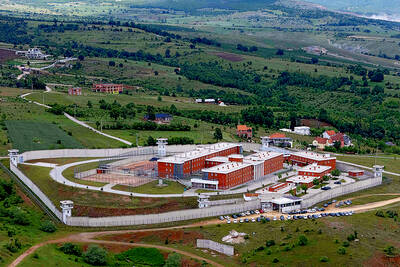A painting by Italian master Caravaggio, once mistakenly thought to be by an unknown artist and nearly auctioned off for a song, was unveiled on Monday at Madrid’s Museo del Prado.
Painted between 1605 and 1609, the dark, atmospheric canvas depicts a bloodied Jesus wearing a crown of thorns, his hands tied, as he is presented to the crowd by the Roman governor Pontius Pilate just before his crucifixion. Entitled Ecce Homo — Latin for “Behold the Man” — it is one of about only 60 known works by the Renaissance artist.
Three years ago, a Madrid auction house had been due to put the canvas under the hammer with an opening price of 1,500 euros (US$1,800 at the time), mistakenly attributing it to an artist from the circle of 17th-century Spanish painter Jose de Ribera.

Photo: AFP
However, just hours before the auction, the Spanish Ministry of Culture blocked the sale on concerns it was actually painted by Michelangelo Merisi da Caravaggio, whose works are worth millions.
The last-minute intervention came after the Prado said it had “sufficient documentary and stylistic evidence” to suggest the canvas was a Caravaggio. The artist, who lived a violent and chaotic life (1571-1610) pioneered the Baroque painting technique known as chiaroscuro, in which light and shadow are sharply contrasted.
Earlier this month, the museum said experts confirmed the painting was “without doubt, a Caravaggio masterpiece,” calling it “one of the greatest discoveries in the history of art.”
Now restored, the old master artwork went on display to the public for the first time on Monday in a one-piece exhibition called “The Lost Caravaggio.” It will remain on display for nine months.
The exhibition was made possible by the “generosity” of its new owner, who agreed to temporarily lend the work, Prado museum director Miguel Falomir told a news conference, without revealing who it was.
The painting’s emergence is “extremely important for the history of art, because there has been no new work by Caravaggio had been identified for more than 45 years,” said David Garcia Cueto, who is responsible for Italian paintings at the Prado.
Experts who have studied its history say this oil on canvas became part of the private collection of Spain’s King Felipe IV in the mid-17th century before being put on display at the residence of his son, Charles II. It was then bequeathed to the San Fernando Royal Academy of Fine Arts near Madrid’s central Puerta del Sol before being passed on to Spanish diplomat and later prime minister Evaristo Perez de Castro in 1823. When he died, it passed to his descendants, only to disappear from view for nearly two centuries until it resurfaced in April 2021. Its reappearance stunned Caravaggio experts who were “absolutely unanimous” in their recognition of the painting’s provenance, Cueto said.
“All the Caravaggio specialists are in agreement which means we are certain that this is a painting by the great master of this period,” he said.
One expert involved in the authentication process was Maria Cristina Terzaghi, an art history professor from Italy’s Roma Tre University who said the canvas underwent “radiographic” techniques and a “meticulous examination.”
She flew into Madrid after the auction was halted, saying her examination left her in no doubt.
“It was clear it was a work by Caravaggio,” she said at the time.
For her, the evidence was ample: from “the head of Christ” to the glow of his torso, the color of his cloak and “the three-dimensional nature of the three figures, who are offset in a transition that is almost cinematic.”
Spanish media reports said the owner was a British national living in Spain who had paid 36 million euros (US$39.2 million at the current exchange rate) for the 400-year-old canvas.
“The painting won’t end up in the home of the buyer” who wants to loan it to “public art collections for now,” Jorge Coll, head of London’s Colnaghi art gallery which handled the sale, told El Pais daily.
However, Falomir said its future was in the hands of its owner.
“It is a privately owned artwork so the owner will have the last word,” he said.

Packed crowds in India celebrating their cricket team’s victory ended in a deadly stampede on Wednesday, with 11 mainly young fans crushed to death, the local state’s chief minister said. Joyous cricket fans had come out to celebrate and welcome home their heroes, Royal Challengers Bengaluru, after they beat Punjab Kings in a roller-coaster Indian Premier League (IPL) cricket final on Tuesday night. However, the euphoria of the vast crowds in the southern tech city of Bengaluru ended in disaster, with Indian Prime Minister Narendra calling it “absolutely heartrending.” Karnataka Chief Minister Siddaramaiah said most of the deceased are young, with 11 dead

By 2027, Denmark would relocate its foreign convicts to a prison in Kosovo under a 200-million-euro (US$228.6 million) agreement that has raised concerns among non-governmental organizations (NGOs) and residents, but which could serve as a model for the rest of the EU. The agreement, reached in 2022 and ratified by Kosovar lawmakers last year, provides for the reception of up to 300 foreign prisoners sentenced in Denmark. They must not have been convicted of terrorism or war crimes, or have a mental condition or terminal disease. Once their sentence is completed in Kosovan, they would be deported to their home country. In

Brazil, the world’s largest Roman Catholic country, saw its Catholic population decline further in 2022, while evangelical Christians and those with no religion continued to rise, census data released on Friday by the Brazilian Institute of Geography and Statistics (IBGE) showed. The census indicated that Brazil had 100.2 million Roman Catholics in 2022, accounting for 56.7 percent of the population, down from 65.1 percent or 105.4 million recorded in the 2010 census. Meanwhile, the share of evangelical Christians rose to 26.9 percent last year, up from 21.6 percent in 2010, adding 12 million followers to reach 47.4 million — the highest figure

LOST CONTACT: The mission carried payloads from Japan, the US and Taiwan’s National Central University, including a deep space radiation probe, ispace said Japanese company ispace said its uncrewed moon lander likely crashed onto the moon’s surface during its lunar touchdown attempt yesterday, marking another failure two years after its unsuccessful inaugural mission. Tokyo-based ispace had hoped to join US firms Intuitive Machines and Firefly Aerospace as companies that have accomplished commercial landings amid a global race for the moon, which includes state-run missions from China and India. A successful mission would have made ispace the first company outside the US to achieve a moon landing. Resilience, ispace’s second lunar lander, could not decelerate fast enough as it approached the moon, and the company has